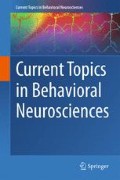Abstract
Here, I provide a basic history of important milestones in the development of theories for how the brain accomplishes the phenomenon of learning and memory. Included are the ideas of Plato, René Descartes, Théodule Ribot, William James, Ivan Pavlov, John Watson, Karl Lashley, and others. The modern era of learning and memory research begins with the description of H.M. by Brenda Milner and the gradual discovery that the brain contains multiple learning and memory systems that are supported by anatomically discrete brain structures. Finally, a brief overview is provided for the chapters that are included in current topics in Behavioral Neuroscience—Learning and Memory.
References
Campbell L (1883) The theaetetus of plato. Oxford University Press
Clark RE (2004) The classical origins of pavlov’s conditioning. Integr Physiol Behav Sci 39(4):279–294
Clark RE (2011) Eyeblink Conditioning and Systems Consolidation: An Ironic Yet Powerful Pairing. Learn Mem 95:118–124
Clark RE, Squire LR (2010) An animal model of recognition memory and medial temporal lobe amnesia: History and current issues. Neuropsychologia 48:2234–2244
Christian KM, Thompson RF (2003) Neural substrates of eyeblink conditioning: acquisition and retention. Learn Mem 11:427–455
Correll RE, Scoville WB (1965) Effects of medial temporal lesions on visual discrimination performance. J comp physiol Psychol. 60:175–181
Descartes, R. (1649). Les passions de l’âme (trans: Stoothoff R). In: The philosophical writings of Descartes, Vol. I. Cambridge University Press, Cambridge (1985)
Douglas RJ (1967) The hippocampus and behavior. Psychol Bull 67(6):416–422
Gaffan D (1974) Recognition impaired and association intact in the memory of monkeys after transaction of the fornix. J Comp Physiol Psychol 88(6):1100–1109
Fanselow MS, Gale GD (2003) The amygdala, fear, and memory. Ann NY Acad Sci 985:125–134
James W (1890) The principles of psychology. Holt, New York
Lashley KS (1929) Brain mechanisms and intelligence. University of Chicago Press, Chicago
Lashley K (1950) In search of the engram. Soc Exp Biol Symp 4:454–482
Mishkin M (1978) Memory in monkeys severely impaired by combined but not separate removal of the amygdala and hippocampus. Nature 273:297–298
Mishkin M, Malamut B, Bachevalier J (1984) Memories and habits: two neural systems. In: Lynch G, McGaugh JL, Weinberger NM (eds) Neurobiology of human learning and memory. Guilford, New York, pp 65–77
Packard MG, Hirsh R, White NM (1989) Differential effects of fornix and caudate nucleus lesions on two radial maze tasks: Evidence for multiple memory systems. J Neurosci 9:1465–1472
Pavlov IP (1906) The scientific investigation of the psychical faculties or processes in the higher animals. Science 24:613–619
Pavlov IP (1927) Conditioned reflexes (trans: Anrep GV). Oxford University Press, London
Plato (circa 396 B.C.). Theaetetus
Ribot T (1881) Les maladies de la mémoire. Baillière, Paris
Ribot T (1882) Diseases of the Memory: an Essay in the Positive Psychology. D. Appleton and Company, New York
Semon R (1904) die Mneme als erhaltendes Prinzip im Wechsel des organischen Geschehens. Wilhelm Engelmann, Leipzig
Scoville WB (1954) The limbic lobe in man. J Neurosurg 11:64–66
Scoville WB, Milner B (1957) Loss of recent memory after bilateral hippocampal lesions. J Neurology, Neurosurg Psychol 20:11–21
Squire LR (1987) Memory and the brain. Oxford University Press, New York
Squire LR (1992) Memory and the hippocampus, A synthesis from findings with rats, monkeys, and humans. Psychol Rev 99:195–231
Tulving E, Schacter DL (1990) Priming and human memory systems. Science 247:301–306
Watson JB (1913) Psychology as the behaviorist views it. Psychol. Rev 20:158–177
Watson JB (1916) The place of the conditioned-reflex in psychology. Psychological Review 23:89–116
Zola-Morgan S, Squire LR (1993) Neuroanatomy of memory. Annual Rev Neurosci 16:547–563
Author information
Authors and Affiliations
Corresponding author
Rights and permissions
Copyright information
© 2018 Springer-Verlag Berlin Heidelberg
About this chapter
Cite this chapter
Clark, R.E. (2018). A History and Overview of the Behavioral Neuroscience of Learning and Memory. In: Current Topics in Behavioral Neurosciences. Springer, Berlin, Heidelberg. https://doi.org/10.1007/7854_2017_37
Download citation
DOI: https://doi.org/10.1007/7854_2017_37
Published:
Publisher Name: Springer, Berlin, Heidelberg

